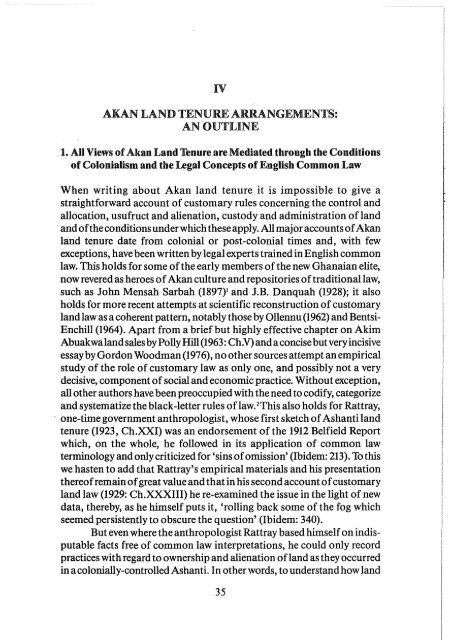You also want an ePaper? Increase the reach of your titles
YUMPU automatically turns print PDFs into web optimized ePapers that Google loves.
IV<br />
AKAN LAND TENURE ARRANGEMENTS:<br />
AN OUTLINE<br />
1. All <strong>View</strong>s of Akan Land Tenure are Mediated through the Conditions<br />
of Colonialism and the Legal Concepts of English Common Law<br />
When writing about Akan land tenure it is impossible to give a<br />
straightforward account of customary rules concerning the control and<br />
allocation, usufruct and alienation, custody and administration of land<br />
and ofthe conditions under which these apply. All major accounts of Akan<br />
land tenure date from colonial or post-colonial times and, with few<br />
exceptions, have been written by legal experts trained in English common<br />
law. This holds for some of the early members of the new Ghanaian elite,<br />
now revered as heroes of Akan culture and repositories of traditional law,<br />
such as John Mensah Sarbah (1897)1 and J.B. Danquah (1928); it also<br />
holds for more recent attempts at scientific reconstruction of customary<br />
land law as a coherent pattern, notably those by Ollennu (1962) and Bentsi<br />
Enchill (1964). Apart from a brief but highly effective chapter on Akim<br />
Abuakwaland sales by Polly Hill (1963: Ch.V) and a concise but very incisive<br />
essay by Gordon Woodman (1976), no other sources attempt an empirical<br />
study of the role of customary law as only one, and possibly not a very<br />
decisive, component of social and economic practice. Without exception,<br />
all other authors have been preoccupied with the need to codify, categorize<br />
and systematize the black -letter rules of law. 2This also holds for Rattray,<br />
. one-time government anthropologist, whose first sketch of Ashanti land<br />
tenure (1923, Ch.XXI) was an endorsement of the 1912 Belfield Report<br />
which, on the whole, he followed in its application of common law<br />
terminology and only criticized for 'sins of omission' (Ibidem: 213). To this<br />
we hasten to add that Rattray's empirical materials and his presentation<br />
thereof remain of great value and that in his second account of customary<br />
land law (1929: Ch.xXXIII) he re-examined the issue in the light of new<br />
data, thereby, as he himself puts it, 'rolling back some of the fog which<br />
seemed persistently to obscure the question' (Ibidem: 340).<br />
But even where the anthropologist Rattray based himself on indisputable<br />
facts free of common law interpretations, he could only record<br />
practices with regard to ownership and alienation ofland as they occurred<br />
in a colonially-controlled Ashanti. In other words, to understand how land<br />
35
















